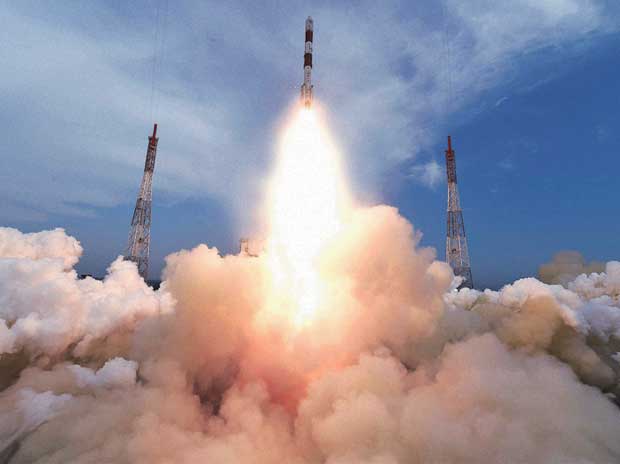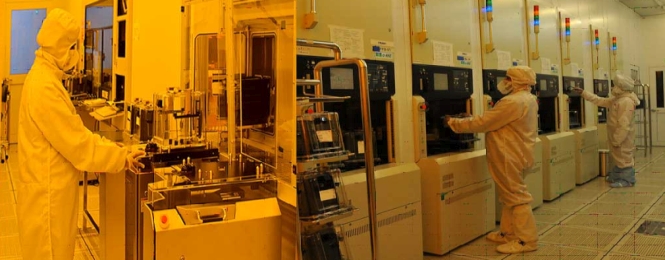Prashant12
Senior Member
- Joined
- Aug 9, 2014
- Messages
- 3,027
- Likes
- 15,002
PSLV C36 Strapon, payload fairing and Resourcesat-2A separation events
Already posted on previous page.PSLV C36 Strapon, payload fairing and Resourcesat-2A separation events
I posted complete video. Which shows from launch to separation events.Already posted on previous page.
THIRUVANANTHAPURAM: Buoyed by the success of the PSLV-C36 launch on Wednesday morning, ISRO units here are focused on the plan for two launch missions including GSLV Mark III and PSLV-C37 by next month.
"The launch of PSLV-C36 on Wednesday marks the success of Indigenous payloads of Isro units including NavIC satellite navigation system, Vikram processor from Semi-conductor labs and indigenous Lithium ion battery," Vikram Sarabhai Space Centre (VSSC) director K Sivan told TOI. It is the 38th PSLV launch that placed 1235 kg Resourcesat-2A satellite into an 817 km polar Sun Synchronous Orbit. Now, the entire team will be focused on two missions by January including GSLV-Mk III and PSLV-C37, he said.
"For the launch of GSLV Mark III with indigenous cryogenic engine by January 2017, preparations have begun. It will carry the heavy 3.2-tonne GSAT-19E communication satellite from Sathish Dhawan Space Centre in Sriharikota," he said.
By evening, scientists of VSSC and Liquid Propulsion Systems Centre (LPSC) returned here after the launch of PSLV-C36 from Sriharikota.
LPSC director S Somnath too told TOI that two launches are planned in January. "PSLV-C37 planned for launch next month will be similar to the PSLV-C36 launch on Wednesday, yet the spacecraft will have new configuration. It is planned to carry an array or cluster of mini-satellites in addition to two major satellites. It will include a combination of domestic and foreign satellites," he told TOI on landing at the airport here.
While, the GSLV-Mk III to place the GSAT-19 satellite is also planned for launch next month and it will be the first developmental flight with indigenous technology, he said.
GSAT-19 satellite will employ advanced spacecraft technologies including bus subsystem experiments in Electrical propulsion System, indigenous Lithium ion battery, indigenous Bus bars for power distribution. The satellite is planned to carry multi-band Ka and Ku payload along with a Geostationary Radiation Spectrometer (GRASP) payload to monitor and study the nature of charged particles and influence of space radiation on spacecraft and electronic components.



Earlier the cameras were used only to capture the climb and the stage separation. Now we see the satellite injection and the solar panel deployment!@Prashant12 @Indx TechStyle .... I think this is the first time ISRO had used onboard camera for capturing the whole launch to release video of any satellite. Seen the live telecast yesterday on TV, heard this news on commentary and was just waiting to see the videos. Thanks a tonnes to you guys..
Now some one post this on Pee Dee Eef
Posted way earlier and no quami folk dared to come. The brave guy whose comments and showed is last.@Prashant12 @Indx TechStyle .... I think this is the first time ISRO had used onboard camera for capturing the whole launch to release video of any satellite. Seen the live telecast yesterday on TV, heard this news on commentary and was just waiting to see the videos. Thanks a tonnes to you guys..
Now some one post this on Pee Dee Eef
It should be fun watching the 83 satellites next month.Earlier the cameras were used only to capture the climb and the stage separation. Now we see the satellite injection and the solar panel deployment!
This sort of video, I never saw even from other agencies.
The heat shield separation video is also there.Earlier the cameras were used only to capture the climb and the stage separation. Now we see the satellite injection and the solar panel deployment!
This sort of video, I never saw even from other agencies.

India's space agency will outsource the manufacture of two navigation satellites, Navic to a consortium of private firms, its first major attempt to share its expertise in satellite making technology that would potentially allow the country to emerge as a major global hub for producing satellites.
So far, firms such as Avasara Technologies, L&T and Godrej have supplied components and systems for the satellites that Indian Space Research Organisation (ISRO) builds to hurl into space.
In June, the space agency opened up consultations with its partners to allow them to form a consortium, absorb the satellite making technology and build satellites first for the space agency's requirements before looking at a global satellite opportunity. Isro will also share the knowhow for building ground equipment that captures satellite data and process them for specific local applications.
The space agency will hand hold the private consortium in building the two Navic satellites, being built as spares to India's navigation constellation.
"The consortium will have companies with expertise in each segment such as electrical, software and others, required for building a satellite. So far the industry has been associated with developing some of the components for the satellite," said ISRO Satellite Centre's Director M Annadurai, but declined to name them. An official announcement is expected next week.
For India, space is emerging as the next growth opportunity as there is a global glut of private satellite companies who are looking for outside expertise to build hundreds of small satellites and launching them on rocket.
"Whenever there is a large production of satellites, there will also be requirement for subsystems. There are many industries which can produce for global companies," said A S Kiran Kumar, chairman of Indian Space Research Organisation (Isro) in an interview in August.
India's PSLV rocket has emerged as the preferred vehicle to launch smaller satellites from global firms such as Spire and PlanetLabs.
So far, ISRO's satellite centre based in Bengaluru has built over 80 satellites - for earth observation and communication, over the last four decades. In the next five years, it needs over 80 satellites to meet the country's demands, which Isro says, would be built by the industry than expanding its own infrastructure.
In 2017, ISRO plans to build and launch 12 homegrown satellites from its spaceport in Sriharikota. At the same time, it would launch dozens of micro and nano satellites for global customers on the PSLV rocket.
ISRO also has set January 20 as the date to launch its heaviest rocket - GSLV Mk-III, which once proven would be the vehicle for the country's manned mission, currently pending approval from the government.
"We are going to have the pad abort test for the HSP (Human Spaceflight Programme). Our milestone is going to continue for every week or every once in two weeks," said Vikram Sarabhai Space Centre director K Sivan.
BHUBANESWAR: The Indian Space Applications Centre (ISRO), Ahmedabad will organize a week long exhibition at Pathani Samanta Planetarium here from December 13 to expose people to astronomy and advanced research on the subject . The exhibition is being held to mark the 10 years of Young Astronomer Talent Search - an annual event to promote interest in astronomy and space sciences among high school students.
The exhibition will feature a mix of static panels, video documentaries and models on a variety of subjects relating to space exploration and research - satellites and their applications, the Chandrayaan and Mars missions, and Satellite Launch Vehicles, among others.
"In a fitting conclusion to the tenth edition of YATS, this initiative is expected to provide valuable real-world exposure to the world of astronomy and space science," said science and technology minister Pradeep Panigrahy.
ISROs geo-portal, the Bhuvan website, will also be demonstrated during the exhibition.
For aspiring students of higher classes, videos will be shown on how to join ISRO.

Chennai: With the successful testing the indigenously developed Vikram processor, NAVIC receiver and lithium battery in the PSLV-C36 mission as ISRO is moving towards having 100% indigenous technology in building and launching the rockets.
“Our target is to have 100% indigenous technology in our rockets and we are moving towards that. Every single device that we are taking from outside now, we are looking to develop it indigenously,” said ISRO chairman A.S. Kiran Kumar told Deccan Chronicle.
“Our Vikram processor which has been realised at our semiconductor’s laboratory in Chandigarh has flown as a piggyback experiment. It has produced excellent results,” he said.
Earlier, the processor used to procured from outside. Now, the processor is fully realised in Semi-Conductor Laboratory (SCL) at Chandigarh. “The design and fabrication of the processor were also done by Isro. So, this is an excellent development,” he said
So far, SCL in Chandigarh has come out with about 75 products like converter, processor and voltage regulator. “We will continue to increase the number of devices that are brought out from SCL as more and more can be used in the electronics hardware. It is a step towards self-reliance,” he said, adding that some of the capability will be augmented in the launch vehicle.
GSLV Mk-III rocket’s tentative launch date is Jan. 20ISRO successfully tested NAVIC receiver by using it for navigating the PSLV-C36 rocket. On being asked whether the NAVIC system is ready for the commercial use he said, “Basic data required for any entrepreneur to build the system is there in the public domain. Some companies are already started making things from available hardware.”
ISRO has fixed tentative launch date for next generation GSLV-Mk-III rocket as January 20.
@LETHALFORCE may be interested aboutt semiconductor laboratory.“We are planning to have the launch on January 20. Since it’s a new mission the launch date may change according to the new observations. Nevertheless, we are aiming for the January launch,” said K. Sivan, director, Vikram Sarabhai Space Centre, Thiruvananthapuram.
Wasn't someone comparing ISRO with HAL, DRDO, ADA et.al lately?????ISRO for 100 per cent indigenous rocket technology soon, says chief
So far, SCL in Chandigarh has come out with about 75 products like converter, processor and voltage regulator.ISRO successfully tested NAVIC receiver by using it for navigating the PSLV-C36 rocket.
GSLV Mk-III rocket’s tentative launch date is Jan. 20
@LETHALFORCE may be interested aboutt semiconductor laboratory.
And sorry, you may have to wait for a week for semiconductor thread. I'm still busy with other issues.
Wasn't someone comparing ISRO with HAL, DRDO, ADA et.al lately?????
 ???????????
???????????In some other thread...... How DRDO, HAL, ADA is guzzling tax payers money and how ISRO is doing wonder with minimal funding and things like that.???????????
30 character rule sucks.
Wasn't someone comparing ISRO with HAL, DRDO, ADA et.al lately?????
???????????
30 character rule sucks.
In some other thread...... How DRDO, HAL, ADA is guzzling tax payers money and how ISRO is doing wonder with minimal funding and things like that.
In last few months, even DRDOs performance wasn't bad, subscribe to the newsletter.In some other thread...... How DRDO, HAL, ADA is guzzling tax payers money and how ISRO is doing wonder with minimal funding and things like that.

In its thirty eighth flight, ISRO's Polar Satellite Launch Vehicle (PSLV-C36), successfully launched the 1,235 kg RESOURCESAT-2A Satellite on December 07, 2016 from Satish Dhawan Space Center SHAR, Sriharikota. This is the thirty seventh consecutively successful mission of PSLV.
After PSLV-C36 lift-off at 10:25 am IST from the First Launch Pad with the ignition of the first stage and the subsequent important flight events took place as planned.

